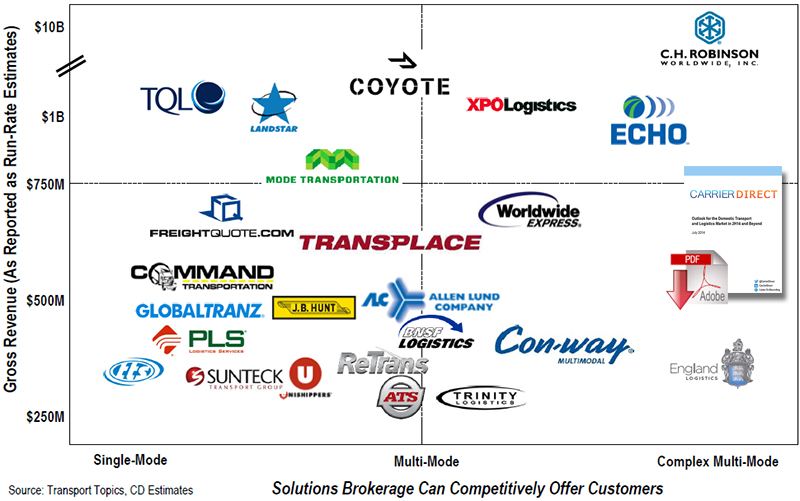Transport & Logistics Report Shows Strong Freight Flow Levels for the Rest of 2014
Now that the pendulum has swung back to carriers, it’s important that they take this opportunity to invest for what the future holds to prepare for inevitable market shifts.
A recent report issued by Chicago-based freight transportation and logistics consultancy CarrierDirect says that freight flows have a bright outlook, following a somewhat difficult beginning to the year.
The report, entitled “Outlook for the Domestic Transport and Logistics Market in 2H14 and Beyond,” takes the view that strong freight levels in the second quarter have left trucking companies in a good position: one in which they need to come up with new plans to handle rising demand.
But even with that positive momentum afloat, the report observes that there are some familiar challenges intact, such as a lack of qualified drivers and the regulatory drag from the new hours-of-service rules that took effect in July 2013.
Along with driver-related challenges and the looming impact of regulations, other major truckload market themes cited by CarrierDirect in the report include how truckload (and LTL carriers as well) are making the decision to allocate assets to dedicated lanes as they’re able to grab more revenue per mile from long-term commitments with customers, as well as noting the opportunity for truckload carriers to convert loads to intermodal but at a limited rate, due to things like rail line congestion and a lack of equipment and asset allocation towards bulk markets.

In an interview with Logistics Management, CarrierDirect President Joel Clum said that CarrierDirect spends a lot of time with asset-based carriers and 3PLs of all sizes, as well as non asset-based carriers, too. But regardless of the size or type of company, one recurring theme Clum has heard from customers is one of optimism.
“It is true optimism and not the cautious optimism that has been a common saying in recent years,” he said. “There are really good freight levels out there, despite the challenges of finding drivers, which continues to be the top challenge for carriers with linehaul in their networks. And people on both the asset and non asset-based side are optimistic about what the freight transportation world hold going forward.”
While optimism is increasing, Clum noted that capacity availability remains an issue, especially for smaller brokerages focusing on LTL and truckload.
These players are fully cognizant that capacity remains a major issue and are aware there will be a capacity-related “squeeze” at some point in the future.
“But those brokers positioned with good carrier relationships that really have invested in those partnerships in past years and did not take advantage of their carrier partners when things were rockier for them are the ones that feel pretty good,” he said.
“Brokers like Coyote, who recently merged with Access America Transport, Echo Global Logistics, and C.H. Robinson, and others, all continue to put up impressive numbers and are doing a good job of accessing the smaller fleets out there. They never really work with the bigger guys like Werner, Swift, Schneider, or Con-way Truckload. But as long as they have the relationship with the top 5-20 truck fleets, they are feeling pretty good.”
The Top Brokerages Continue to Get Bigger And Offer More Services

And on the carrier side, challenges remain for finding drivers for long lengths of haul lanes. But with the capacity crunch, he said they are still seeing good profitability coming back into their businesses, which has not played out this way in nearly a decade.
Things driving this for truckload carriers include demand for dedicated lanes and getting more creative with large shippers to get good round trip revenue-per-mile, even if they do not have enough assets to dedicate towards the dedicated opportunities they currently have with shippers.
For mid-size carriers, Clum pointed to a strong spot market pricing environment in working with brokers and shippers. But at the same time they are finding good dedicated opportunities as well.
“On the truckload side, it seems like carriers are pretty confident in the way rates are coming back in their favor so they can invest in new equipment and technology,” he said.
“And it can also create a problem for 3PLs that set rates for customers at a specific price per mile, plus fuel, and then they start to see those rates increase on the spot market (by up to 10-20 percent, depending on lane and region), depending on where they are in the U.S. This has forced some 3PLs to rethink their pricing strategy with customers.”
Related: Top 50 Global & Domestic Third-Party Logistics Providers
For the LTL sector, CarrierDirect highlighted three key themes:
- how to deal with the problem of having too much freight in their networks and the right way to “purge” the bad freight strategically that won’t backfire when freight levels ease;
- LTL carriers being affected by the good and bad spillover from the truckload market: huge challenge in finding Linehaul drivers (P&D not so much a problem), but also getting the potential benefit from the freight spillage that moves from truckload to LTL; and
- technology is the next big initiative for LTL carriers who see the writing on the wall that the better they know their network the better they’ll be able to generate profit (if management makes the right decisions with it).
For the latter point, examples of technology driving LTL performance include things like dimensioners or linehaul planning software or TMS or other ways to make costing models more effective so LTL carriers can look at their networks more scientifically or be more precise overall, said Clum.
“The days of LTL carriers wanting freight because it is class 50 and it comes well cubed out regardless of the price because it will help cube their trailer really well are over,” he said.
“Now, we are seeing the advent of dimensioners and better costing systems the allocation of the cost to the shipment will pick up for linehaul for your dock management for delivery. And you can actually see on a shipment-by-shipment basis that there is freight that plays well with others but is not pricing correctly.
We are seeing carriers with so much freight in their network now that are going back to shippers and telling them that the rates they are charging them are not conducive to their relationship, so it needs to be re-priced or we need to part ways because it is not worth it to the carrier anymore.”
Related: Top 50 Less-than-Truckload & Truckload Trucking Companies













